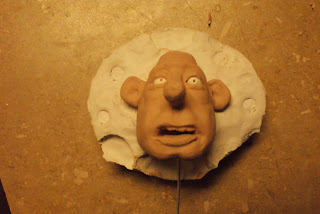So at the beginning of the casting process I laid the head in a bed of plasticine (oil-based, non-drying clay) up to the ears, an area that will eventually become the seam line. I placed wire into the eyes and mouth in order to reinforce the plaster that would be poured there. I also added 'keys' to help align the mold later.
I also made a wall of plasticine around the bed contain the plaster as it dries. From there I applied plaster with a brush into the crevices of the sculpt to allow for better detail capture.
Then I poured the plaster into the mold casing and allowed it to dry for 24 hours (the recommended time). Otherwise the plaster is too soft and crumbly for the other side of the mold to be complete. For the other side of the mold, I used the same process: plasticine walls, poured plaster, allow to cure. I also used a soap and water mold release, as suggested by the good people of the internet.
Unfortunately, when it came time to pry apart the mold halves, they would not budge. After much sawing and prying, the mold remained hard as a brick. I could only surmise that the release agent did not work and the two halves stuck together, incasing my original sculpt inside.
This was pretty bad because it meant not only all those hours of mold-making were lost, but that my original was now encased in a block of plaster, meaning I would have to resculpt his head. Not eager to make the same mistake twice, I then made some smaller dummy molds to test different release agents.
One was made using the soapy water method as before to make sure it wasn't a fluke, and the other was with vaseline, which while being the right consistency for release can sometimes add too much bulk between mold halves.
After letting both molds sit, I found that the vaseline worked beautifully even though the keys broke off (I didn't let the plaster dry fully in order to see more immediate results). The soapy water release stuck together like the first mold and confirmed that it sucked. Armed with new knowledge, I began again.
Now the irony is that a full 24 hours after my attempt to pull apart the original mold, I sat down to document my failure. And wouldn't you know it, I could finally pry the mold apart. Now, the mold was still damaged and unusable, but at least I could salvage most of my original sculpt, which was a definite plus. If the mold halves had met together and didn't have big openings around the seams, I probably could have worked with this shitty mold, but I really don't need to waste more time.


























